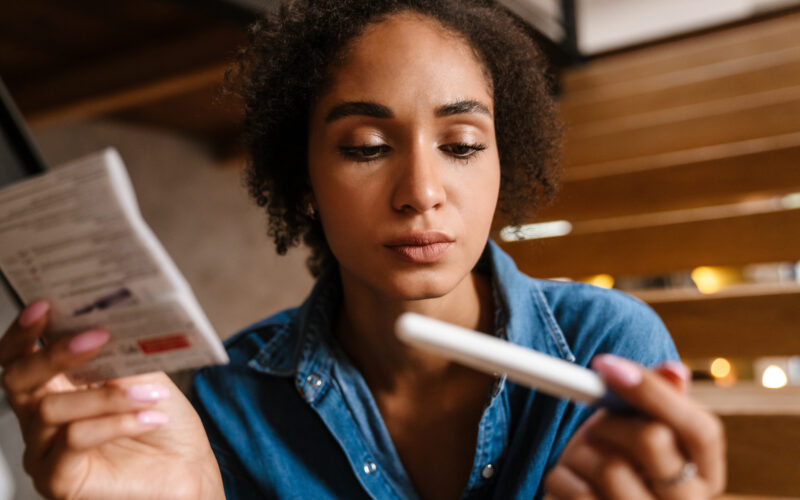“Could I be pregnant?”
Millions of women of reproductive age are thinking about this question right now. According to Hoff et al., 3 out of 5 women of reproductive age have experienced a “pregnancy scare” that can last anywhere from a few days to a few weeks [1]. But what many women don’t realize is that the stress of the “2 week wait” for onset of a menstrual period can be minimized by knowing the facts about possible conception, possible signs of implantation, symptoms of early pregnancy and—most importantly—how and when to test for pregnancy.
If you or someone you have experienced a “scare” (or think you could in the future!), this article is for you.
Let’s start at the beginning: Conception
Conception is the joining of two gametes (reproductive cells)—one from a man (sperm) and one from a woman (ovum or egg). These cells are unique in that they are haploid, meaning half of the genetic code needed to make an embryo; they each only contain 23 chromosomes. All the other cells in our body have the complete set of 46 chromosomes, making up our personal “book of life” genome. In other words, sperm cells and egg cells are incomplete on their own. To fulfill their purpose, they need each other. (Cue the “you complete me” Jerry Maguire reference.)
In all seriousness, conception is truly a miraculous, fireworks-worthy moment.
When you consider that it would take a whole year of random acts of unprotected intercourse for only 85 percent of couples to conceive and become pregnant, you begin to realize that while making a new human life is normal, it isn’t exactly what you can call common.
No, you can’t get pregnant “anytime”
Here’s the truth: Most of us are only capable of conceiving about six (6) days per cycle, regardless of whether you have a regular cycle length (about 21-35 days) or not. (And if you want to learn when your average of 6 days of possible fertility are, it’s time to learn a Fertility Awareness Method!)
Finding your “fertile window”
Another way to put this:
If you have an average length cycle of, say, 30 days from day 1 of your period to the next, you are only fecund (a word meaning “fertile,” or “capable of conceiving”) about 20% of the time. Continuing to work with the numbers, if you have a longer cycle you may be a little less fecund (proportionally speaking); a shorter cycle, maybe a little more fecund. Maybe.
But wait, that’s not all it takes to get pregnant
The ability to conceive includes a lot of other variables, including:
- Health or patency (openness) of the Fallopian tubes that sperm have to swim through to get to the egg (and where conception actually happens!)
- Presence and quality of the cervical fluid that sperm have to swim through to get to the egg
- Quality of the sperm themselves
- Quality of ovulation or release of the egg
In other words, conception is multi-factoral. The moment a woman’s DNA from her egg joins with a man’s DNA from his sperm to make a unique, unrepeatable human life is a moment worthy of awe and wonder. And of course, it’s just Step 1! Now, let’s talk about Step 2, the actual pregnancy.
Implantation: The beginning of the Mother-Child connection
After the sperm meets the egg (known as fertilization or conception), the brand new human life (known now as a blastocyst) travels down mom’s Fallopian tube and reaches her uterus after about day 5–6. At the uterine lining (endometrium), the embryo “hatches” from a protective shell and attaches. Tiny finger-like projections secure the tiny life to the endometrium while the mother’s blood supply begins making complex, biological connections to establish a food supply, plus waste removal and gas exchange, for the growing baby.
If all goes well, the pregnancy will progress and the mother’s body will grow a new, amazing mini organ—the placenta—to keep the supply of nutrients going between her and her child. The placenta also starts making hCG or human chorionic gonadotropin, aka “the pregnancy hormone.” This hormone supports progression of the pregnancy by helping to maintain the uterine lining. It also supports continued, increased production of progesterone.
hCG levels will rise to levels detectable in urine about 12-14 days after conception, so before wasting a bunch of money on pregnancy tests—wait! Try not to do a home test until a full 2 weeks after suspected conception, as those tests measure urine hCG levels.
Another fun fact? A human at the blastocyst stage of development is already genetically programmed as male or female (chromosomal sex XY or XX, respectively)—which was determined at the moment of conception.
So how do you know if implantation has occurred?
The short answer is: you may not be able to tell if implantation has occurred. However, some women catch possible signs of implantation, which include:
- Light spotting or “implantation bleeding” (usually pink or brown, lighter than a period)
- Mild cramping or a pulling sensation in the lower abdomen
- Slight rise in basal body temperature—a very useful thing to be tracking!
- Breast tenderness or fullness from early hormonal shifts
- Increased fatigue as progesterone rises
Obstetrics 101: How to detect pregnancy
With successful implantation, you have the start of pregnancy. The most obvious symptoms of early pregnancy include:
- A missed menstrual period (which is tricky if you have irregular cycles—although tracking ovulation via a FAM can help eliminate the guesswork)
- Nausea
- Breast tenderness
- Increased urinary frequency
- Fatigue [2]
If you are experiencing these symptoms and suspect pregnancy, the best thing to do is a urine test for hCG. (Important: Use your first morning urine. It will contain the highest concentration of hCG, therefore giving you the most accurate result.)
Also important: A urine pregnancy test has a high degree of accuracy by 12 days after possible conception. Think about when unprotected intercourse occurred. And, again, try not to test too soon (I know, it’s hard!).
A blood test is best
Home pregnancy tests run from $1 to over $20. They are 99% accurate, but it is important to know about unique circumstances (i.e. testing too soon or being on fertility medications) that may produce a false negative or false positive.
If you really want an accurate, quicker answer to the question of “am I pregnant”—go to your doctor. A routine blood test for beta hCG is highly accurate within 8 to 10 days of possible conception. Additionally, if you are pregnant, doing your pregnancy test at a doctor’s office means you can get qualified medical advice and initiate prenatal care right away.
And, in case you’re in need of it, there is a caring network of healthcare professionals nationwide who can provide free pregnancy tests.
If you don’t have access to a doctor
Pregnancy resource centers (PRCs) are very worth knowing about if you think you could be pregnant. These centers usually provide (free) pregnancy tests, and may also offer ultrasounds done by licensed ultrasonographers. An ultrasound is the next step after the positive beta hCG blood test. It not only gives you your first baby pictures, it also tells you the gestational age of your child.
Gestational age lets you know how much longer before you can find out the sex of your child, or, much later, when you can test for gestational diabetes. It also determines whether or not it is safe for you to take certain medications that may impact the health of your child, or even the progression of your pregnancy. The effects of mifepristone offer one dramatic example of the importance of knowing how far along you are before taking a drug.
If you’d like free pregnancy testing and an ultrasound, here’s a directory of PRCs across the U.S..
Debunking common pregnancy misconceptions
To recap, you now know that the following several pregnancy misconceptions are just that—misconceptions—and more importantly, you know why!
Myth #1: “You can get pregnant any day of your cycle.”
Truth: Pregnancy is only possible during a specific fertile window, which is about 5 days before ovulation and the day of ovulation itself. Sperm can live up to 5 days, but the egg only survives about 12–24 hours after ovulation. So, while it seems like pregnancy could happen anytime, it’s actually only likely during a short window (about 6 days) each cycle.
Myth #2: “You can’t get pregnant if he pulls out.”
Truth: Pre-ejaculate (pre-cum) can contain sperm, especially if a man has ejaculated recently. So pregnancy is still possible even without full ejaculation during vaginal intercourse—if you’re within the fertile window, of course.
Myth #3 “You can’t get pregnant during your period.”
Truth: While it’s less likely, it’s not impossible to get pregnant on your period. Some women ovulate very early in their cycle, and sperm can live in the body for several days in the presence of cervical mucus. If a woman has short cycles, sex during her period could overlap with her earlier-than-average fertile window.
Myth #4: “Douching, urinating, or showering after sex prevents pregnancy.”
Truth: These actions do not remove sperm from the cervix or uterus. Once sperm enters the cervical canal (which can happen within seconds), none of these methods will stop fertilization.
My #5: “You can always tell when you’re ovulating.”
Truth: Ovulation isn’t always predictable, especially if cycles are irregular. However, tracking fertility signs like cervical mucus, basal body temperature, or LH surges can help you track ovulation—but only in retrospect. And these signs are most reliable when someone is tracking their cycle consistently using a fertility awareness method (FAM), after being educated by a certified FAM instructor.
Myth #6: “If you’re breastfeeding, you can’t get pregnant.”
Truth: Breastfeeding can delay a return to ovulation, especially in the first 6 months postpartum if the baby is exclusively breastfeeding and mom hasn’t gotten her period yet. But it’s not a guaranteed method of avoiding pregnancy, especially once feeding patterns change or cycles return.
Myth #7: “You can’t get pregnant right after stopping birth control.”
Truth: Many women can ovulate and conceive quickly after stopping hormonal birth control—sometimes within weeks. Fertility returns at different rates, but it’s not unusual to become pregnant soon after stopping the pill, patch, or shot (although the return to fertility after the birth control shot often takes longer).
The bottom line
Many in-home hormone testing product websites such as this one have more information on facts and fallacies when you are thinking about the possibility of pregnancy. And of course, Natural Womanhood has plenty of information to dive into about everything from trying to conceive to pregnancy health if that test is negative or positive.
If you are wondering if you are pregnant, or how you can know that you are (and how early), you aren’t alone. That’s why all of the above information is so important for any woman of child-bearing age. In the end, if you do have reason to suspect a pregnancy, don’t hesitate to see a healthcare professional or visit a pregnancy resource center so that you can receive the most accurate information about your pregnancy or gestational age of your new baby.
Additional resources
Plan B and abortion pills
Had unprotected sex, and wondering if you should take Plan B? Here’s the truth about how often Plan B works to prevent pregnancy.
Did you take an abortion pill and now regret it? Here’s the truth about whether abortion pill reversal works.
Miscarriage fears
Concerned about the possibility of miscarriage? Here’s how early progesterone support might help.
Are you possibly suffering a miscarriage? Here is what after-miscarriage care looks like, and here are some resources for emotional healing after miscarriage and other forms of child loss







